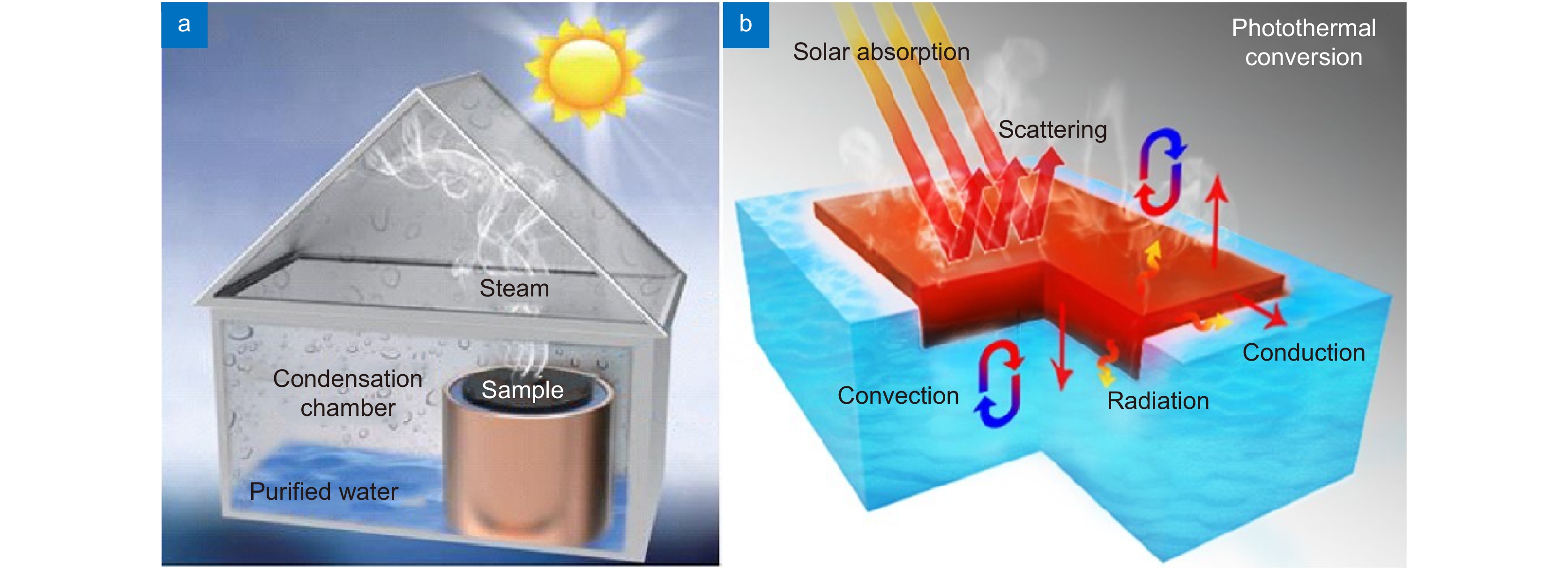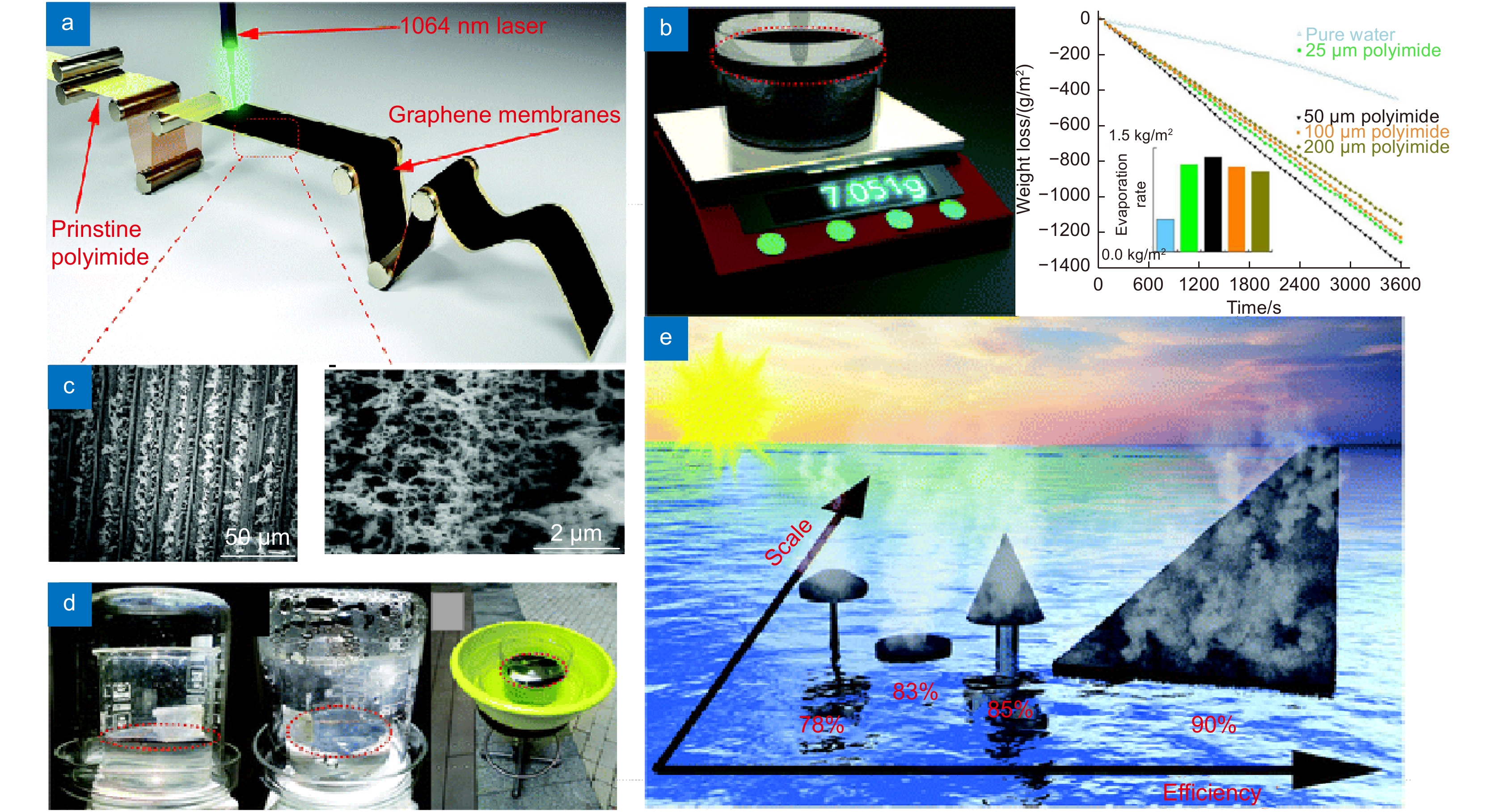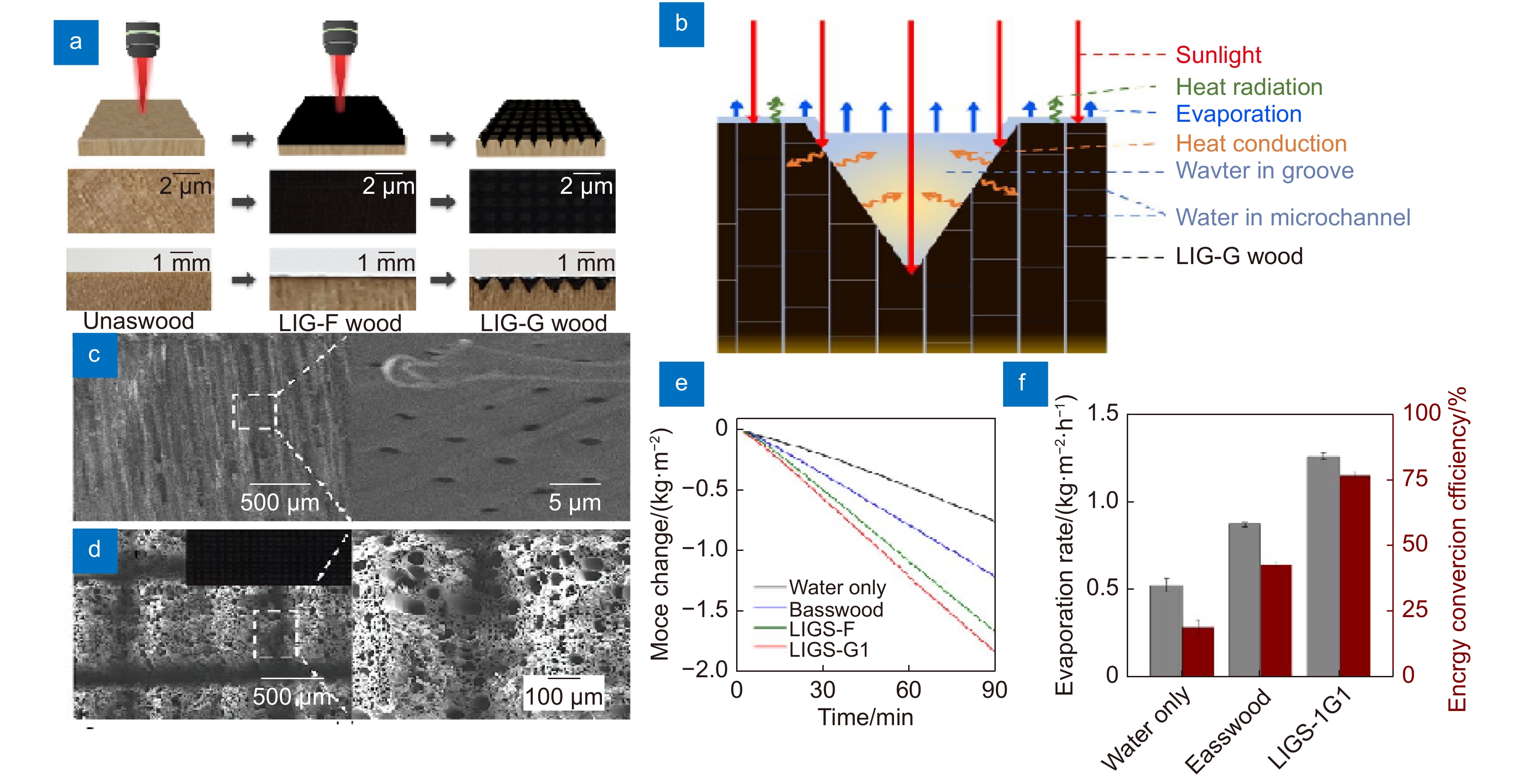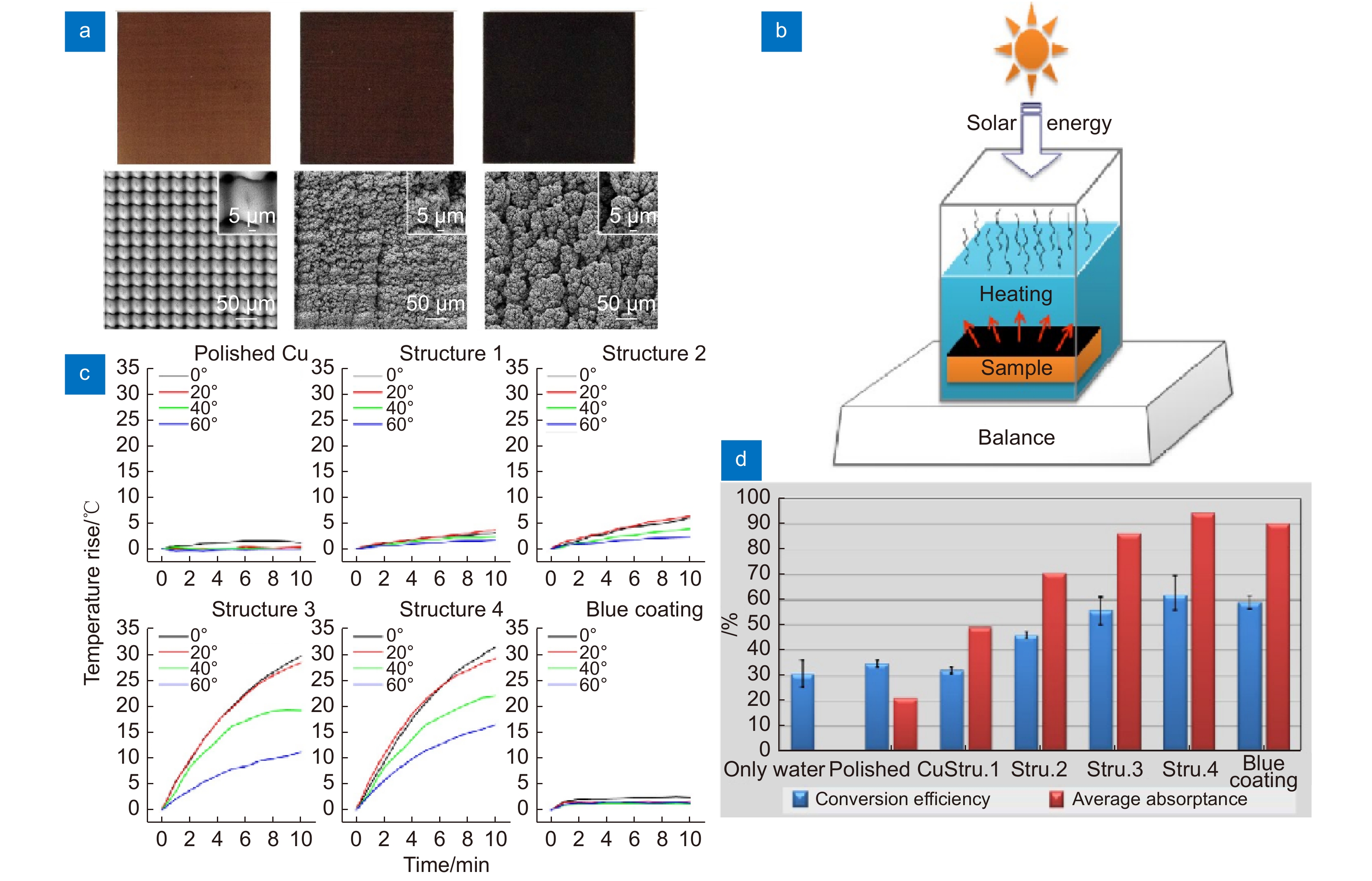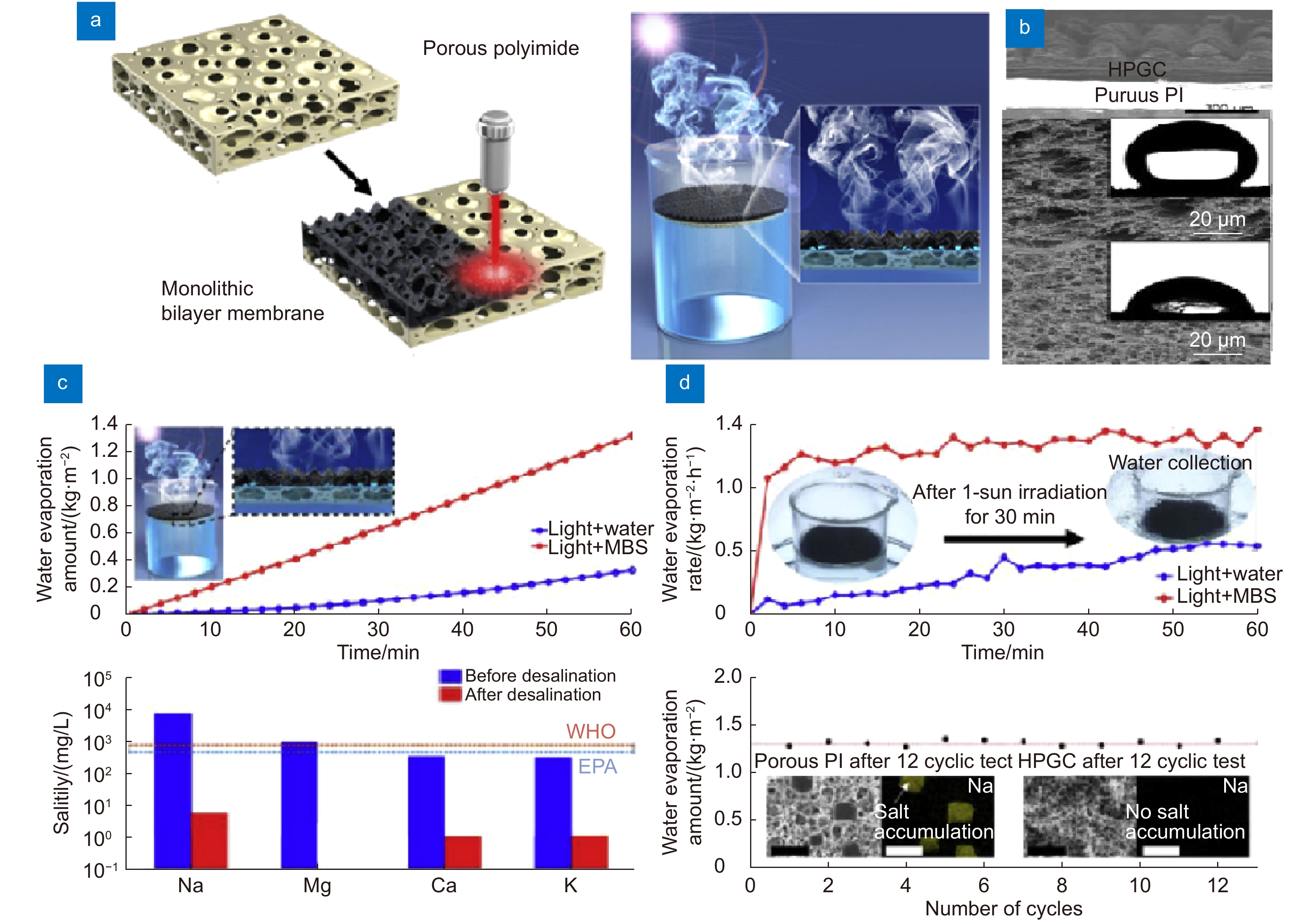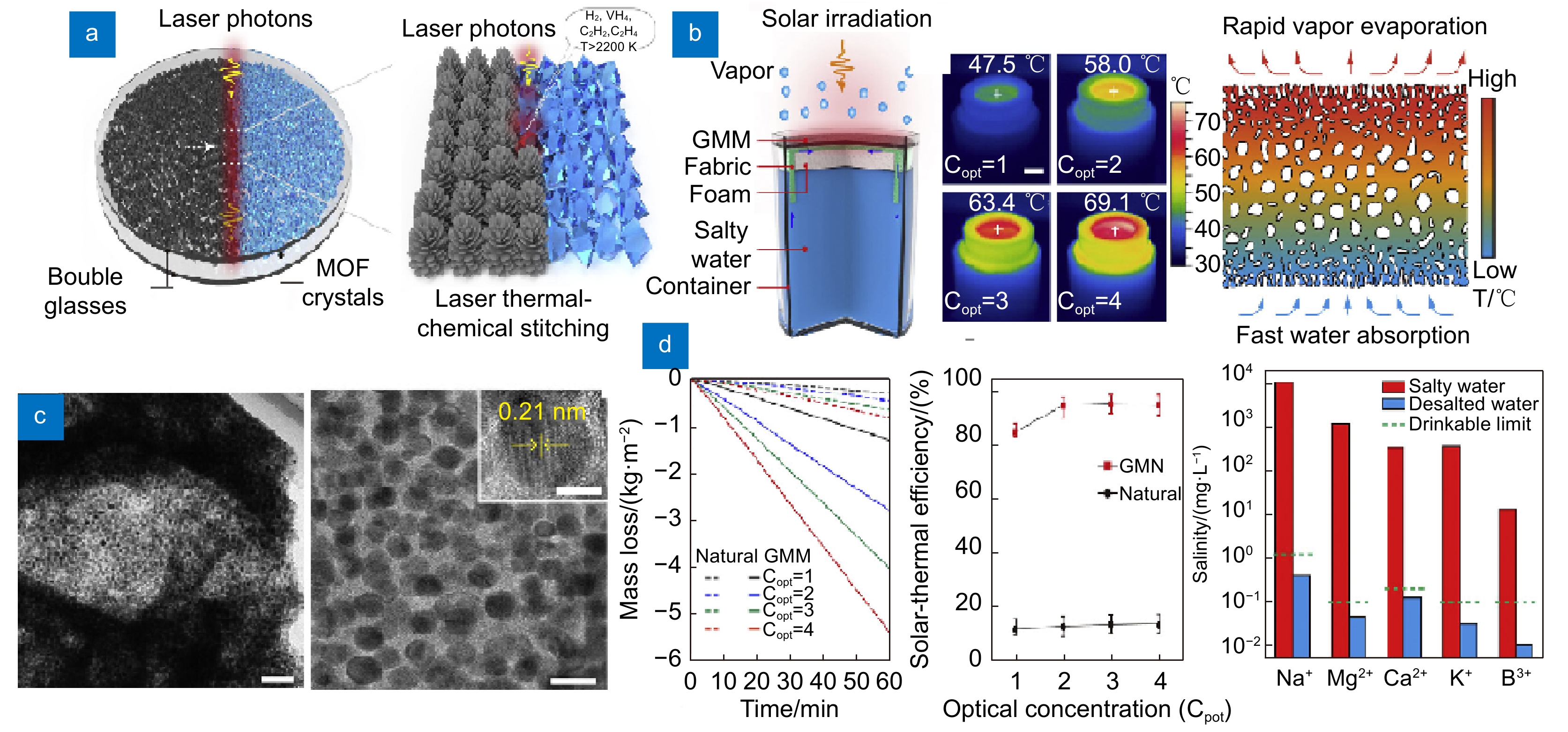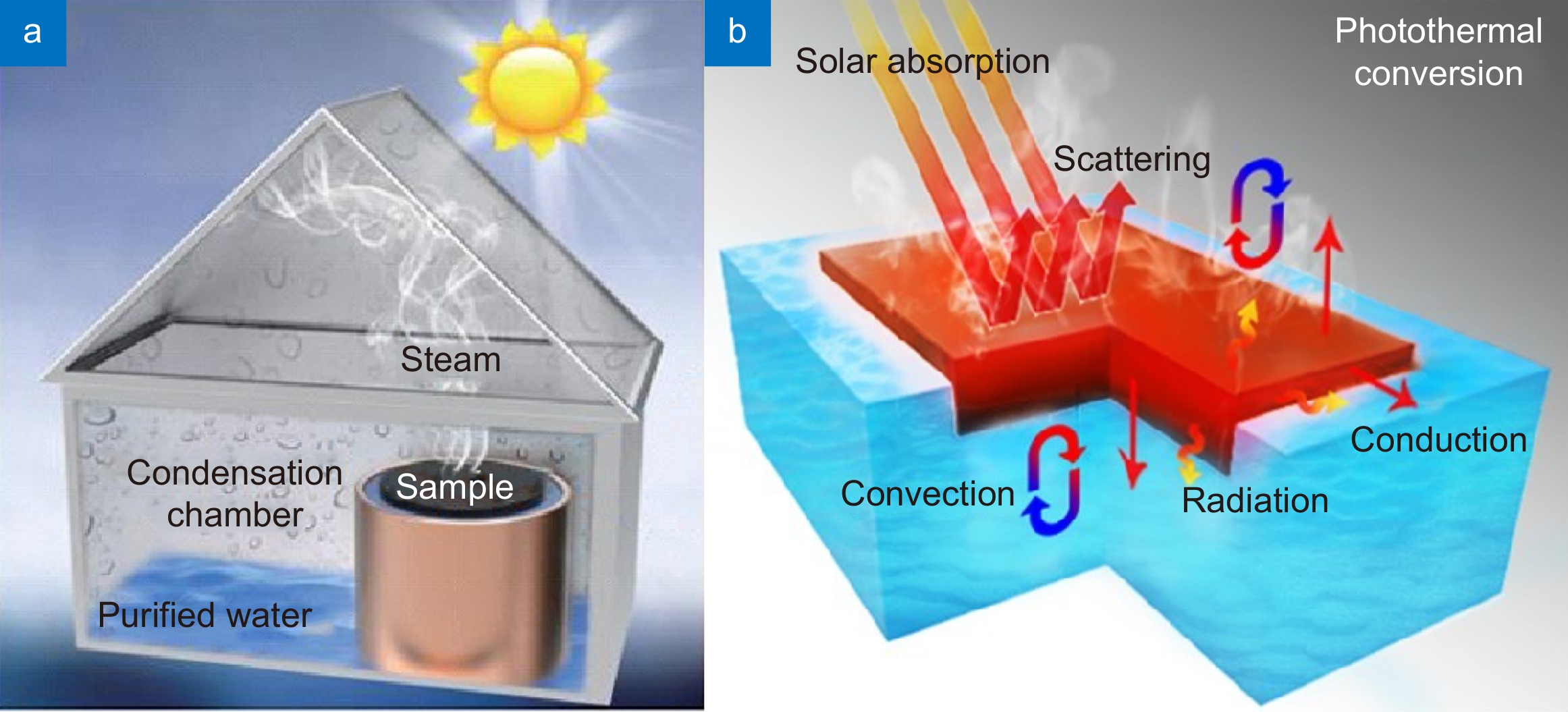Research progress of solar desalination materials produced by laser micro-nano fabrication
-
摘要:
海水淡化技术在解决水资源短缺的问题上起着重要的作用,其中太阳能海水技术的研究#更是备受关注。激光微纳制造技术作为一种先进、便捷的加工方法,近年来在制备海水淡化材料领域取得了一定的研究成果。本文以太阳能海水淡化技术以及激光加工技术作为研究背景,根据研究材料的多样性,从材料的构成本质出发,将近年来关于激光微纳制造海水淡化材料的研究分为碳基类、金属基类和复合基类材料三个部分来进行阐述,最后结合当前研究,阐明该方向面临的挑战并对其前景进行展望。
Abstract:The seawater desalination technology plays an important role in solving the problem of water shortage. In particular, the research of solar seawater technology has attracted more research and industry attentions. As an advanced and convenient processing method, laser micro/nano-manufacturing technology has made some achievements in the field of preparing seawater desalination materials in recent years. Based on the solar desalination and laser processing technologies as the research background, according to diverse research materials, we summarize the research progress of laser micro/nano-manufacturing technology in the preparation of seawater desalination materials from three different aspects, including carbon-based, metal-based and composite materials. Finally, challenges and prospects of this field are provided.
-
Key words:
- laser /
- micro and nano-fabrication /
- solar /
- desalination
-
Overview: Seawater desalination technology plays an important role in solving the problem of water resource shortage. In particular, the research of solar seawater technology has attracted more attentions. As an advanced and convenient fabrication method, laser micro/nano-preparation technology has achieved some research results in the field of fabricating the seawater desalination materials in recent years. Based on the research background of solar desalination and laser processing technology, this paper systematically reviews the research progress of laser micro/nano-processing technology to prepare seawater desalination materials in recent years.
In the study of solar water desalination, functional materials are made to improve the efficiency of solar water evaporation. In addition, the position of functional materials in water also greatly affects the light utilization rate. A large number of studies have shown that placing functional materials on water surface is the most efficient mode to utilize light. Based on this model, not only do the functional materials require excellent optical properties, which can ensure efficient broadband solar absorption, but also they need good thermal management capabilities in order to reduce heat loss. With the development of research, people have higher requirements on machining accuracy and material functionality. However, traditional micro/nano-processing methods, such as chemical treatment, can not well meet the needs. Therefore, after a long time of exploration, laser micro/nano-machining is favored because of its high power density, high precision, wide application range and other advantages. It gradually becomes an important method in the field of micro/nano-processing, and has been widely used in the study of seawater desalination materials. The researches on laser manufacturing of seawater desalination materials in recent years are divided into three parts: carbon based, metal based and composite based materials.
The development of seawater desalination technology and laser micro/nano-processing technology are still in its infancy, and there is still a long way to go before they can be applied in industrial production. However, with the deepening of research, a new generation of high-power and high-frequency lasers will develop rapidly. The laser micro/nano-machining technology will provide higher manufacturing efficiency and operation stability at the lower cost, and the mechanism of laser processing technology will be understood more clearly. It is believed that laser micro/nano-processing will gradually promote the practice of solar water desalination and become an important research field in the future.
-

-
-
[1] Xia Y, Kang Y, Wang Z Y, et al. Rational designs of interfacial-heating solar-thermal desalination devices: recent progress and remaining challenges[J]. J Mater Chem A, 2021, 9(11): 6612−6633. doi: 10.1039/D0TA11911C
[2] Mekonnen M M, Hoekstra A Y. Four billion people facing severe water scarcity[J]. Sci Adv, 2016, 2(2): e1500323. doi: 10.1126/sciadv.1500323
[3] Shannon M A, Bohn P W, Elimelech M, et al. Science and technology for water purification in the coming decades[J]. Nanosci Technol, 2009: 337−346. doi: 10.1038/nature06599
[4] Shatat M, Worall M, Riffat S. Opportunities for solar water desalination worldwide: Review[J]. Sust Cit Soc, 2013, 9: 67−80. doi: 10.1016/j.scs.2013.03.004
[5] El-Sadek A. Water desalination: An imperative measure for water security in Egypt[J]. Desalination, 2010, 250(3): 876−884. doi: 10.1016/j.desal.2009.09.143
[6] Youssef P G, Al-Dadah R K, Mahmoud S M. Comparative analysis of desalination technologies[J]. Energy Proc, 2014, 61: 2604−2607. doi: 10.1016/j.egypro.2014.12.258
[7] Elimelech M, Phillip W A. The future of seawater desalination: energy, technology, and the environment[J]. Science, 2011, 333(6043): 712−717. doi: 10.1126/science.1200488
[8] Khawaji A D, Kutubkhanah I K, Wie J M. Advances in seawater desalination technologies[J]. Desalination, 2008, 221(1-3): 47−69. doi: 10.1016/j.desal.2007.01.067
[9] Peñate B, García-Rodríguez L. Current trends and future prospects in the design of seawater reverse osmosis desalination technology[J]. Desalination, 2012, 284: 1−8. doi: 10.1016/j.desal.2011.09.010
[10] Al-Karaghouli A, Kazmerski L L. Energy consumption and water production cost of conventional and renewable-energy-powered desalination processes[J]. Renew Sust Energy Rev, 2013, 24: 343−356. doi: 10.1016/j.rser.2012.12.064
[11] Miller S, Shemer H, Semiat R. Energy and environmental issues in desalination[J]. Desalination, 2015, 366: 2−8. doi: 10.1016/j.desal.2014.11.034
[12] Lee K P, Arnot T C, Mattia D. A review of reverse osmosis membrane materials for desalination—Development to date and future potential[J]. J Membrane Sci, 2011, 370(1-2): 1−20. doi: 10.1016/j.memsci.2010.12.036
[13] Ahmed F E, Hashaikeh R, Hilal N. Solar powered desalination–Technology, energy and future outlook[J]. Desalination, 2019, 453: 54−76. doi: 10.1016/j.desal.2018.12.002
[14] Kumar A, Kumar K, Kaushik N, et al. Renewable energy in India: current status and future potentials[J]. Renew Sust Energy Rev, 2010, 14(8): 2434−2442. doi: 10.1016/j.rser.2010.04.003
[15] Chu S, Majumdar A. Opportunities and challenges for a sustainable energy future[J]. Nature, 2012, 488(7411): 294−303. doi: 10.1038/nature11475
[16] Lewis N S. Research opportunities to advance solar energy utilization[J]. Science, 2016, 351(6271): aad1920. doi: 10.1126/science.aad1920
[17] Arunkumar T, Jayaprakash R, Denkenberger D, et al. An experimental study on a hemispherical solar still[J]. Desalination, 2012, 286: 342−348. doi: 10.1016/j.desal.2011.11.047
[18] Kabeel A E, Khalil A, Omara Z M, et al. Theoretical and experimental parametric study of modified stepped solar still[J]. Desalination, 2012, 289: 12−20. doi: 10.1016/j.desal.2011.12.023
[19] Omara Z M, Kabeel A E, Younes M M. Enhancing the stepped solar still performance using internal reflectors[J]. Desalination, 2013, 314: 67−72. doi: 10.1016/j.desal.2013.01.007
[20] Sivakumar V, Sundaram E G. Improvement techniques of solar still efficiency: A review[J]. Renew Sust Energy Rev, 2013, 28: 246−264. doi: 10.1016/j.rser.2013.07.037
[21] Dumitru G, Lüscher B, Krack M, et al. Laser processing of hardmetals: Physical basics and applications[J]. Int J Refract Met Hard Mater, 2005, 23(4-6): 278−286. doi: 10.1016/j.ijrmhm.2005.04.020
[22] Naeem M. Laser processing of reflective materials: a new technology managing reflection effects[J]. Laser Techn J, 2013, 10(1): 18−20. doi: 10.1002/latj.201390001
[23] Phillips K C, Gandhi H H, Mazur E, et al. Ultrafast laser processing of materials: a review[J]. Adv Opt Photon, 2015, 7(4): 684−712. doi: 10.1364/AOP.7.000684
[24] Zhang C H, Cao M Y, Ma H Y, et al. Morphology‐control strategy of the superhydrophobic Poly (Methyl Methacrylate) surface for efficient bubble adhesion and wastewater remediation[J]. Adv Funct Mater, 2017, 27(43): 1702020. doi: 10.1002/adfm.201702020
[25] 吴雪峰, 尹海亮, 李强. 飞秒激光加工碳纳米管薄膜试验研究[J]. 中国激光, 2019, 46(9): 0902002. doi: 10.3788/CJL201946.0902002
Wu X F, Yin H L, Li Q. Femtosecond laser processing of carbon nanotubes film[J]. Chin J Lasers, 2019, 46(9): 0902002. doi: 10.3788/CJL201946.0902002
[26] 王子涵, 王宝续, 釜野勝, 等. 基于激光干涉烧蚀的硅表面微纳结构制备研究[J]. 激光与光电子学进展, 2019, 56(16): 163201. doi: 10.3788/LOP56.163201
Wang Z H, Wang B X, Fu Y S, et al. Fabrication of silicon micro/nanostructures based on laser interference ablation[J]. Laser Optoelectron Prog, 2019, 56(16): 163201. doi: 10.3788/LOP56.163201
[27] Allmen M V, Blatter A. Laser-Beam Interactions with Materials: Physical Principles and Applications[M]. 2nd ed. Berlin: Springer Science & Business Media, 2013.
[28] Liao Y L, Ye C, Cheng G J. A review: Warm laser shock peening and related laser processing technique[J]. Opt Laser Technol, 2016, 78: 15−24. doi: 10.1016/j.optlastec.2015.09.014
[29] Malinauskas M, Žukauskas A, Hasegawa S, et al. Ultrafast laser processing of materials: from science to industry[J]. Light Sci Appl, 2016, 5(8): e16133−e16133. doi: 10.1038/lsa.2016.133
[30] Zhang B, Wang L, Chen F. Recent advances in femtosecond laser processing of LiNbO3 crystals for photonic applications[J]. Laser Photonics Rev, 2020, 14(8): 1900407. doi: 10.1002/lpor.201900407
[31] Hecht J. A short history of laser development[J]. Appl Opt, 2010, 49(25): F99−F122. doi: 10.1364/AO.49.000F99
[32] Yiannakou C, Simitzi C, Manousaki A, et al. Cell patterning via laser micro/nano structured silicon surfaces[J]. Biofabrication, 2017, 9(2): 025024. doi: 10.1088/1758-5090/aa71c6
[33] Aizawa T, Inohara T, Wasa K. Femtosecond Laser Micro-/nano-texturing of stainless steels for surface property control[J]. Micromachines (Basel), 2019, 10(8): 512. doi: 10.3390/mi10080512
[34] Kwon M H, Shin H S, Chu C N. Fabrication of a super-hydrophobic surface on metal using laser ablation and electrodeposition[J]. Appl Surf Sci, 2014, 288: 222−228. doi: 10.1016/j.apsusc.2013.10.011
[35] Chitnis G, Ding Z W, Chang C L, et al. Laser-treated hydrophobic paper: an inexpensive microfluidic platform[J]. Lab Chip, 2011, 11(6): 1161−1165. doi: 10.1039/c0lc00512f
[36] Farshchian B, Gatabi J R, Bernick S M, et al. Laser-induced superhydrophobic grid patterns on PDMS for droplet arrays formation[J]. Appl Surf Sci, 2017, 396: 359−365. doi: 10.1016/j.apsusc.2016.10.153
[37] Das R, Arunachalam S, Ahmad Z, et al. Bio-inspired gas-entrapping membranes (GEMs) derived from common water-wet materials for green desalination[J]. J Membr Sci, 2019, 588: 117185. doi: 10.1016/j.memsci.2019.117185
[38] Mason A, Mohammadighaleni M, Nejati S. Fabrication of composite membranes for solar-thermal desalination[J]. 2020, 4: 1–6.
[39] Wang Y L, Li G J, Chan K C. Cost-effective and eco-friendly laser-processed cotton paper for high-performance solar evaporation[J]. Sol Energy Mater Sol Cells, 2020, 218: 110693. doi: 10.1016/j.solmat.2020.110693
[40] Cao X W, Chen Q D, Fan H, et al. Liquid-assisted femtosecond laser precision-machining of silica[J]. Nanomaterials, 2018, 8(5): 287. doi: 10.3390/nano8050287
[41] Chong T C, Hong M H, Shi L P. Laser precision engineering: from microfabrication to nanoprocessing[J]. Laser Photonics Rev, 2010, 4(1): 123−143. doi: 10.1002/lpor.200810057
[42] Ullah I, Rasul M G. Recent developments in solar thermal desalination technologies: a review[J]. Energies, 2019, 12(1): 119. doi: 10.3390/en12010119
[43] Sharon H, Reddy K S. A review of solar energy driven desalination technologies[J]. Renew Sust Energy Rev, 2015, 41: 1080−1118. doi: 10.1016/j.rser.2014.09.002
[44] Zhang P P, Liao Q H, Yao H Z, et al. Direct solar steam generation system for clean water production[J]. Energy Stor Mater, 2019, 18: 429−446. doi: 10.1016/j.ensm.2018.10.006
[45] Dwivedi V K, Tiwari G N. Experimental validation of thermal model of a double slope active solar still under natural circulation mode[J]. Desalination, 2010, 250(1): 49−55. doi: 10.1016/j.desal.2009.06.060
[46] Mahdi J T, Smith B E, Sharif A O. An experimental wick-type solar still system: design and construction[J]. Desalination, 2011, 267(2-3): 233−238. doi: 10.1016/j.desal.2010.09.032
[47] Hou W B, Cronin S B. A review of surface plasmon resonance‐enhanced photocatalysis[J]. Adv Funct Mater, 2013, 23(13): 1612−1619. doi: 10.1002/adfm.201202148
[48] Zijlstra P, Paulo P M R, Orrit M. Optical detection of single non-absorbing molecules using the surface plasmon resonance of a gold nanorod[J]. Nat Nanotechnol, 2012, 7(6): 379−382. doi: 10.1038/nnano.2012.51
[49] Zhang D Q, Wen M C, Zhang S S, et al. Au nanoparticles enhanced rutile TiO2 nanorod bundles with high visible-light photocatalytic performance for NO oxidation[J]. Appl Catal B:Environ, 2014, 147: 610−616. doi: 10.1016/j.apcatb.2013.09.042
[50] Ishii S, Sugavaneshwar R P, Chen K, et al. Solar water heating and vaporization with silicon nanoparticles at mie resonances[J]. Opt Mater Expr, 2016, 6(2): 640−648. doi: 10.1364/OME.6.000640
[51] Fang Z Y, Zhen Y R, Neumann O, et al. Evolution of light-induced vapor generation at a liquid-immersed metallic nanoparticle[J]. Nano Lett, 2013, 13(4): 1736−1742. doi: 10.1021/nl4003238
[52] Guo A K, Ming X, Fu Y, et al. Fiber-based, double-sided, reduced graphene oxide films for efficient solar vapor generation[J]. ACS Appl Mater Interfaces, 2017, 9(35): 29958−29964. doi: 10.1021/acsami.7b07759
[53] Han D X, Meng Z G, Wu D X, et al. Thermal properties of carbon black aqueous nanofluids for solar absorption[J]. Nanoscale Res Lett, 2011, 6(1): 457. doi: 10.1186/1556-276X-6-457
[54] Chang C, Yang C, Liu Y M, et al. Efficient solar-thermal energy harvest driven by interfacial plasmonic heating-assisted evaporation[J]. ACS Appl Mater Interfaces, 2016, 8(35): 23412−23418. doi: 10.1021/acsami.6b08077
[55] Wang X, Liu Q C, Wu S Y, et al. Multilayer polypyrrole nanosheets with self‐organized surface structures for flexible and efficient solar–thermal energy conversion[J]. Adv Mater, 2019, 31(19): 1807716. doi: 10.1002/adma.201807716
[56] Ito Y, Tanabe Y, Han J H, et al. Multifunctional porous graphene for high‐efficiency steam generation by heat localization[J]. Adv Mater, 2015, 27(29): 4302−4307. doi: 10.1002/adma.201501832
[57] Lin X F, Chen J Y, Yuan Z K, et al. Integrative solar absorbers for highly efficient solar steam generation[J]. J Mater Chem A, 2018, 6(11): 4642−4648. doi: 10.1039/C7TA08256H
[58] Li T, Liu H, Zhao X P, et al. Scalable and highly efficient mesoporous wood‐based solar steam generation device: localized heat, rapid water transport[J]. Adv Funct Mater, 2018, 28(16): 1707134. doi: 10.1002/adfm.201707134
[59] Zhou L, Tan Y L, Ji D X, et al. Self-assembly of highly efficient, broadband plasmonic absorbers for solar steam generation[J]. Sci Adv, 2016, 2(4): e1501227. doi: 10.1126/sciadv.1501227
[60] Liu H D, Zhang X T, Hong Z X, et al. A bioinspired capillary-driven pump for solar vapor generation[J]. Nano Energy, 2017, 42: 115−121. doi: 10.1016/j.nanoen.2017.10.039
[61] Liu Y M, Chen J W, Guo D W, et al. Floatable, self-cleaning, and carbon-black-based superhydrophobic gauze for the solar evaporation enhancement at the air–water interface[J]. ACS Appl Mater Interfaces, 2015, 7(24): 13645−13652. doi: 10.1021/acsami.5b03435
[62] Lou J W, Liu Y, Wang Z Y, et al. Bioinspired multifunctional paper-based rGO composites for solar-driven clean water generation[J]. ACS Appl Mater Interfaces, 2016, 8(23): 14628−14636. doi: 10.1021/acsami.6b04606
[63] McEnaney K, Weinstein L, Kraemer D, et al. Aerogel-based solar thermal receivers[J]. Nano Energy, 2017, 40: 180−186. doi: 10.1016/j.nanoen.2017.08.006
[64] Zhou L, Tan Y L, Wang J Y, et al. 3D self-assembly of aluminium nanoparticles for plasmon-enhanced solar desalination[J]. Nat Photonics, 2016, 10(6): 393−398. doi: 10.1038/nphoton.2016.75
[65] Gao M M, Zhu L L, Peh C K, et al. Solar absorber material and system designs for photothermal water vaporization towards clean water and energy production[J]. Energy Environ Sci, 2019, 12(3): 841−864. doi: 10.1039/C8EE01146J
[66] Yang H, Liu G Y, Zou H B, et al. The design of a solar desalination device control system[J]. J Hangzhou Dianzi Univ, 2014, 34(1): 79−82.
[67] Boriskina S V, Tong J K, Hsu W C, et al. Heat meets light on the nanoscale[J]. Nanophotonics, 2016, 5(1): 134−160. doi: 10.1515/nanoph-2016-0010
[68] Yao J D, Zheng Z Q, Yang G W. Alloying-assisted phonon engineering of layered BiInSe3@ nickel foam for efficient solar-enabled water evaporation[J]. Nanoscale, 2017, 9(42): 16396−16403. doi: 10.1039/C7NR04374K
[69] Yao J D, Zheng Z Q, Yang G W. Layered tin monoselenide as advanced photothermal conversion materials for efficient solar energy-driven water evaporation[J]. Nanoscale, 2018, 10(6): 2876−2886. doi: 10.1039/C7NR09229F
[70] Ni G, Li G, Boriskina S V, et al. Steam generation under one sun enabled by a floating structure with thermal concentration[J]. Nat Energy, 2016, 1(9): 16126. doi: 10.1038/nenergy.2016.126
[71] Wei T Q, Li X Q, Li J L, et al. Interfacial solar vapor generation[J]. Chin Sci Bull, 2018, 63(14): 1404−1416. doi: 10.1360/N972018-00344
[72] Little D J, Ams M, Dekker P, et al. Femtosecond laser modification of fused silica: the effect of writing polarization on Si-O ring structure[J]. Opt Expr, 2008, 16(24): 20029−20037. doi: 10.1364/OE.16.020029
[73] Sugioka K, Cheng Y. Femtosecond laser processing for optofluidic fabrication[J]. Lab Chip, 2012, 12(19): 3576−3589. doi: 10.1039/c2lc40366h
[74] Wu J R, He J, Yin K, et al. Robust hierarchical porous PTFE film fabricated via femtosecond laser for self-cleaning passive cooling[J]. Nano Lett, 2021, 21(10): 4209−4216. doi: 10.1021/acs.nanolett.1c00038
[75] Wu Z P, Yin K, Wu J R, et al. Femtosecond laser micro-nano fabrication of underwater gas wettable surface[J]. Laser Optoelectr Progr, 2020, 57(11): 111418. doi: 10.3788/LOP57.111418
[76] Sugioka K, Xu J, Wu D, et al. Femtosecond laser 3D micromachining: a powerful tool for the fabrication of microfluidic, optofluidic, and electrofluidic devices based on glass[J]. Lab Chip, 2014, 14(18): 3447−3458. doi: 10.1039/C4LC00548A
[77] Yin K, Dong X R, Zhang F, et al. Superamphiphobic miniature boat fabricated by laser micromachining[J]. Appl Phys Lett, 2017, 110(12): 121909. doi: 10.1063/1.4979036
[78] Wu J R, Yin K, Li M, et al. Under-oil self-driven and directional transport of water on a femtosecond laser-processed superhydrophilic geometry-gradient structure[J]. Nanoscale, 2020, 12(6): 4077−4084. doi: 10.1039/C9NR09902F
[79] Vorobyev A Y, Guo C L. Direct femtosecond laser surface nano/microstructuring and its applications[J]. Laser Photonics Rev, 2017, 7(3): 385−407. doi: 10.1002/lpor.201200017
[80] Ye R Q, James D K, Tour J. M. Laser-induced graphene[J]. Acc Chem Res, 2018, 51(7): 1609−1620. doi: 10.1021/acs.accounts.8b00084
[81] Ye R Q, James D K, Tour J M. Laser-induced graphene: from discovery to translation[J]. Adv Mater, 2019, 31(1): e1803621. doi: 10.1002/adma.201803621
[82] Barbhuiya N H, Kumar A, Singh S P. A journey of laser-induced graphene in water treatment[J]. Trans Indian Nat Acad Eng, 2021, 6(2): 159−171. doi: 10.1007/s41403-021-00205-2
[83] Wang F C, Wang K D, Zheng B X, et al. Laser-induced graphene: preparation, functionalization and applications[J]. Mater Technol, 2018, 33(5): 340−356. doi: 10.1080/10667857.2018.1447265
[84] Tittle C M, Yilman D, Pope M A, et al. Robust superhydrophobic laser-induced graphene for desalination applications[J]. Adv Mater Technol, 2018, 3(2): 1700207. doi: 10.1002/admt.201700207
[85] Cheng L, Guo W H, Cao X H, et al. Laser-induced graphene for environmental applications: progress and opportunities[J]. Mater Chem Front, 2021, 5(13): 4874−4891. doi: 10.1039/D1QM00437A
[86] Yang H C, Hou J, Chen V, et al. Janus membranes: exploring duality for advanced separation[J]. Angew Chem Int Ed Engl, 2016, 55(43): 13398−13407. doi: 10.1002/anie.201601589
[87] Yang Y B, Yang X D, Fu L N, et al. Two-dimensional flexible bilayer Janus membrane for advanced photothermal water desalination[J]. ACS Energy Lett, 2018, 3(5): 1165−1171. doi: 10.1021/acsenergylett.8b00433
[88] Li G J, Law W C, Chan K C. Floating, highly efficient, and scalable graphene membranes for seawater desalination using solar energy[J]. Green Chem, 2018, 20(16): 3689−3695. doi: 10.1039/C8GC01347K
[89] Akhavan M, Schofield J, Jalili S. Water transport and desalination through double-layer graphyne membranes[J]. Phys Chem Chem Phys, 2018, 20(19): 13607−13615. doi: 10.1039/C8CP02076K
[90] Jang H, Choi J, Lee H, et al. Corrugated wood fabricated using laser-induced graphitization for salt-resistant solar steam generation[J]. ACS Appl Mater Interfaces, 2020, 12(27): 30320−30327. doi: 10.1021/acsami.0c05138
[91] Ye R Q, Chyan Y, Zhang J B, et al. Laser‐induced graphene formation on wood[J]. Adv Mater, 2017, 29(37): 1702211. doi: 10.1002/adma.201702211
[92] Ghafurian M M, Niazmand H, Goharshadi E K, et al. Enhanced solar desalination by delignified wood coated with bimetallic Fe/Pd nanoparticles[J]. Desalination, 2020, 493: 114657. doi: 10.1016/j.desal.2020.114657
[93] Fan P X, Wu H, Zhong M L, et al. Large-scale cauliflower-shaped hierarchical copper nanostructures for efficient photothermal conversion[J]. Nanoscale, 2016, 8(30): 14617−14624. doi: 10.1039/C6NR03662G
[94] Yang S, Yin K, Chu D K, et al. Femtosecond laser structuring of Janus foam: Water spontaneous antigravity unidirectional penetration and pumping[J]. Appl Phys Lett, 2018, 113(20): 203701. doi: 10.1063/1.5061723
[95] Kim M, Yang K, Kim Y S, et al. Laser-induced photothermal generation of flexible and salt-resistant monolithic bilayer membranes for efficient solar desalination[J]. Carbon, 2020, 164: 349−356. doi: 10.1016/j.carbon.2020.03.059
[96] Jiang H Q, Tong L, Liu H D, et al. Graphene-metal-metastructure monolith via laser shock-induced thermochemical stitching of MOF crystals[J]. Matter, 2020, 2(6): 1535−1549. doi: 10.1016/j.matt.2020.03.003
-


 E-mail Alert
E-mail Alert RSS
RSS

 下载:
下载:
